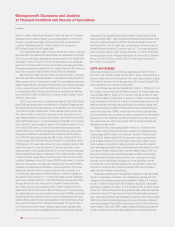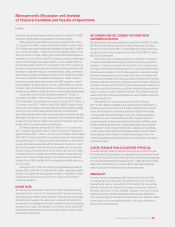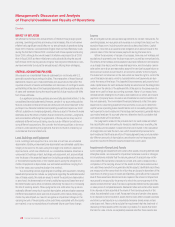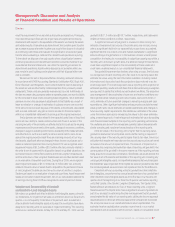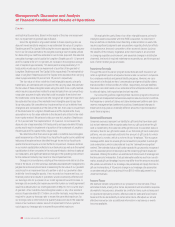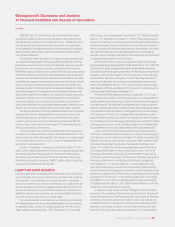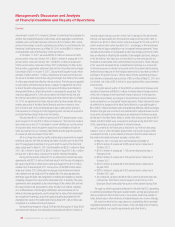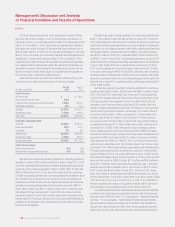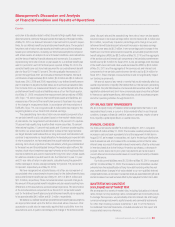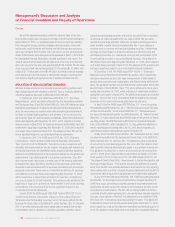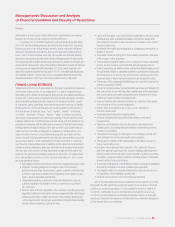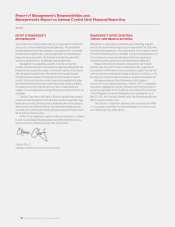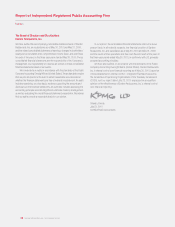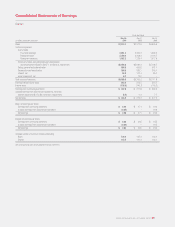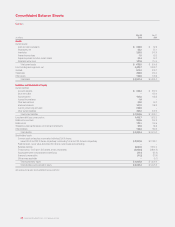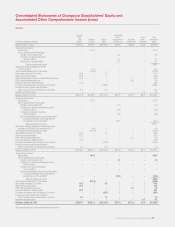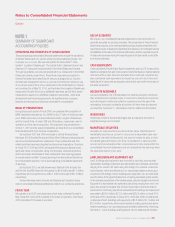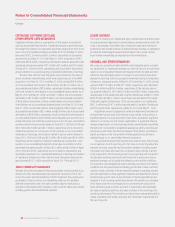Red Lobster 2010 Annual Report Download - page 36
Download and view the complete annual report
Please find page 36 of the 2010 Red Lobster annual report below. You can navigate through the pages in the report by either clicking on the pages listed below, or by using the keyword search tool below to find specific information within the annual report.
34 DARDEN RESTAURANTS, INC. | 2010 ANNUAL REPORT
Notes to Consolidated Financial Statements
Darden Restaurants
34 DARDEN RESTAURANTS, INC. | 2010 ANNUAL REPORT
Management’s Discussion and Analysis
of Financial Condition and Results of Operations
Darden
We use the variance/covariance method to measure value at risk, over
time horizons ranging from one week to one year, at the 95 percent confidence
level. At May 30, 2010, our potential losses in future net earnings resulting
from changes in foreign currency exchange rate instruments, commodity
instruments, equity forwards and floating rate debt interest rate exposures
were approximately $32.8 million over a period of one year (including the
impact of the interest rate swap agreements discussed in Note 10 of the Notes
to Consolidated Financial Statements, included elsewhere in this report). The
value at risk from an increase in the fair value of all of our long-term fixed rate
debt, over a period of one year, was approximately $129.4 million. The fair value
of our long-term fixed rate debt during fiscal 2010 averaged $1.62 billion, with
a high of $1.73 billion and a low of $1.48 billion. Our interest rate risk manage-
ment objective is to limit the impact of interest rate changes on earnings and
cash flows by targeting an appropriate mix of variable and fixed rate debt.
APPLICATION OF NEW ACCOUNTING STANDARDS
We have included reference to previously issued accounting guidance as it
was originally issued with reference to the ASC Topic or Subtopic where the
respective guidance has been codified within the FASB ASC.
In September 2006, the FASB issued SFAS No. 157, “Fair Value
Measurements,” which has been codified into the Fair Value Measurements
and Disclosures Topic (Topic 820) of the FASB ASC. Topic 820 defines fair value,
establishes a framework for measuring fair value and enhances disclosures
about fair value measures required under other accounting pronouncements,
but does not change existing guidance as to whether or not an instrument is
carried at fair value. For financial assets and liabilities, Topic 820 is effective for
fiscal years beginning after November 15, 2007, which required us to adopt
these provisions in fiscal 2009. For nonfinancial assets and liabilities, Topic 820
is effective for fiscal years beginning after November 15, 2008, which required
us to adopt these provisions in fiscal 2010. The adoption of Topic 820 did not
have a significant impact on our consolidated financial statements.
In December 2007, the FASB issued SFAS No. 141R, “Business
Combinations,” which has been codified into the Business Combinations
Topic (Topic 805) of the FASB ASC. Topic 805 provides companies with
principles and requirements on how an acquirer recognizes and measures in
its financial statements the identifiable assets acquired, liabilities assumed,
and any noncontrolling interest in the acquiree as well as the recognition and
measurement of goodwill acquired in a business combination. Topic 850
also requires certain disclosures to enable users of the financial statements
to evaluate the nature and financial effects of the business combination.
Acquisition costs associated with the business combination will generally be
expensed as incurred. The provisions in Topic 805 are effective for business
combinations occurring in fiscal years beginning after December 15, 2008,
which required us to adopt these provisions for business combinations
occurring in fiscal 2010 and thereafter. This guidance was adopted at the
beginning of fiscal 2010 and will be implemented for any future business
combinations. The adoption did not have a significant impact on our
consolidated financial statements.
In June 2008, the FASB issued FASB Staff Position (FSP) EITF 03-6-1,
“Determining Whether Instruments Granted in Share-Based Payment
Transactions Are Participating Securities,” which has been codified into the
Earnings Per Share Topic of the FASB ASC, within Subtopic 260-10. Subtopic
260-10 provides that unvested share-based payment awards that contain
nonforfeitable rights to dividends or dividend equivalents (whether paid or
unpaid) are participating securities and shall be included in the computation
of earnings per share pursuant to the two-class method. The two-class
method is an earnings allocation method for computing earnings per share
when an entity’s capital structure includes either two or more classes of
common stock or common stock and participating securities. It determines
earnings per share based on dividends declared on common stock and
participating securities (i.e., distributed earnings) and participation rights
of participating securities in any undistributed earnings. This guidance is
effective for fiscal years beginning after December 15, 2008, which required
us to adopt these provisions in fiscal 2010. The adoption of this guidance did
not have a significant impact on our consolidated financial statements.
In December 2008, the FASB issued FSP 132(R)-1, “Employers’
Disclosures about Postretirement Benefit Plan Assets,” which expands the
disclosure requirements about fair value measurements of plan assets for
pension plans, postretirement medical plans, and other funded postretirement
plans. This guidance has been incorporated into the Compensation-Retirement
Benefits Topic of the FASB ASC (Topic 715) and is effective for fiscal years
ending after December 15, 2009, which required us to adopt these provisions
during the fourth quarter of fiscal 2010. The additional disclosures are included
in Note 17 of the notes to the consolidated financial statements included
elsewhere in this report and incorporated herein by reference.
In April 2009, the FASB issued FSP SFAS No. 107-1 and Accounting
Principles Board (APB) Opinion No. 28-1, “Interim Disclosures about Fair Value
of Financial Instruments,” which amends SFAS No. 107, “Disclosures about
Fair Value of Financial Instruments” and APB Opinion No. 28, “Interim Financial
Reporting,” to require disclosures about the fair value of instruments for interim
reporting periods. This FSP has been codified into the Financial Instruments
Topic of the FASB ASC, within Subtopic 825-10. This guidance is effective for
interim reporting periods ending after June 15, 2009, which required us to
adopt these provisions during the first quarter of fiscal 2010.
In May 2009, the FASB issued SFAS No. 165, “Subsequent Events,” which
has been incorporated into the Subsequent Events Topic of the FASB ASC,
within Subtopic 855-10. Subtopic 855-10 establishes general standards
of accounting for and disclosing events that occur after the balance sheet
date but before financial statements are issued or are available to be issued.
This guidance is effective for interim and annual periods ending after
June 15, 2009, which required that we adopt these provisions in the first
fiscal quarter of 2010. In February 2010, the FASB issued ASU 2010-09,
“SubsequentEvents(Topic855)–AmendmentstoCertainRecognitionand
Disclosure Requirements.” This update removes the definition of a public
entity from the ASC and amends disclosure requirements by only requiring
those entities that do not file or furnish financial statements with the SEC to
disclose the date through which subsequent events have been evaluated.
In July 2009, the FASB issued SFAS No. 168, “FASB Accounting Standards
Codification,” as the single source of authoritative nongovernmental U.S.
GAAP. As a result, all existing accounting standard documents have been
superseded. All other accounting literature not included in the ASC will be
considered non-authoritative. The ASC did not change GAAP but instead
combined all authoritative guidance into a comprehensive, topically organized
structure. Upon adoption of the ASC, this statement is now codified in FASB
ASC Topic 105, “Generally Accepted Accounting Principles.” This statement
is effective for interim and annual periods ending after September 15, 2009,
which required us to adopt this statement during the second fiscal quarter of
2010. The adoption of this Statement did not impact the consolidated financial


